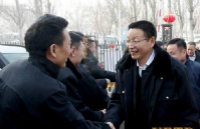China clarifies new five-year plan at key forum
(Xinhua) Updated: 2016-03-22 00:21BEIJING -- Chinese policymakers illustrated how to carry out the newly released 13th Five-Year Plan, showing confidence on sustained growth in the next five years at a forum.
The two-day China Development Forum, which ended here on Monday, was an annual event initiated by the Development Research Center of the State Council, a government think tank, in 2000.
It was eye-catching this year as 2016 is the start of the plan, having attracted not only officials, academics and entrepreneurs, but also heads of international organizations such as IMF managing director Christine Lagarde and leaders of heavyweight companies such as Facebook.
BETTER MACRO POLICIES
Despite the obvious downward pressure, China's economic fundamentals remain sound, and its economy is tenacious with sufficient potential and leeway, said Xu Shaoshi, head of the National Development and Reform Commission, the top economic planner.
China will continue to improve and innovate macroeconomic policies, provide better forecasts on growth, and coordinate financial, monetary, industrial, regional, investment and consumption policies, he said.
The country will boost range-based, targeted and discretionary macro regulation to provide a stable environment for structural reforms, he noted.
The plan outlines a policy framework, as well as priorities and economic and social development goals, including an innovation-driven development strategy and an average annual growth rate of above 6.5 percent for the years leading to 2020.
The growth target for 2016 was set in the range of 6.5 percent and 7 percent in early March.
NO SEPARATE CARBON TAX, MORE VAT REFORM
Finance Minister Lou Jiwei said there will be no separate carbon tax, and instead, a carbon tax is likely to be incorporated into either the environmental protection tax or resource tax.
Talking about individual income tax, he admitted the current system was "unreasonable" and said an official plan for its reform will be ratified by the State Council, the cabinet.
From May 1, China will expand a value-added tax (VAT) program and replace business tax across the board, he said.
The country has long imposed VAT on tangible goods, but services are subject to business tax, which is based on the value of a firm's sales.
Such a crude system results in a tax on tax: It is charged on the taxes already priced in the supplies they buy. VAT avoids this, as it is applied to the value added at each link in the chain of production.
The program, which began in 2012, has reduced the tax burden of enterprises, most of which are small entities, by 641.2 billion yuan (100 billion U.S. dollars) by the end of 2015.
LOWER DEBT RATIO
The central bank governor Zhou Xiaochuan said the country's economic leverage ratio was relatively high, especially the debt-GDP ratio.
He attributed it to the high saving-rate, which leads to more financing through banks and bonds, but less from the capital market.
One solution is to boost the capital market and channel more savings into the equity financing to cut the debt-GDP ratio.
He called for a diversified financial institution system that can help various financing packages supplement each other, such as commercial financing, development financing, policy-based financing and cooperative financing.
China will stick to the prudent monetary policy, he reiterated in early March.
- Xi and Germany's Gauck promote new opportunities
- Identity stolen, woman deprived of campus life
- Emotions contribute most to sleep troubles
- China says any third party will not affect its ties with Cuba
- President Xi meets German counterpart on stronger ties
- Image makeover: Perception of govt officials needs new look
- $88m vaccine sales case triggers probe
- China's 'Tianqin' program starts infrastructure construction
- Students get into the swing for spring
- Blacklist urged to halt invasive species







